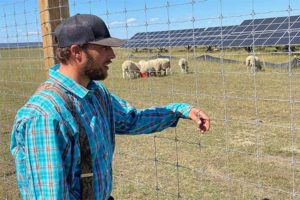In a world that’s increasingly concerned with sustainability and ecological balance, a new industry is emerging that unites two seemingly disparate fields: agriculture and solar power. This industry, affectionately named “agri-solar,” has been gaining traction in numerous parts of the country, setting an inspiring precedent for the sustainable cohabitation of technology and nature.
The symbiosis of agriculture and solar energy
At first glance, sprawling agricultural land and sleek solar panels might seem like odd bedfellows. However, the unique coupling of these two domains offers a symbiotic solution that not only produces renewable energy but also aids in maintaining sustainable agricultural practices.
In the agri-solar model, vast tracts of agricultural land are utilized to accommodate solar panels. These solar installations, rather than usurping the space for farming activities, work in unison with them. The land under and around the solar panels remains viable for farming, specifically for grazing farm animals such as sheep, goats, or even chickens.
Harmonious Benefits: cleaner energy, sustainable farming, and economic growth

The just-published study with lambs and solar panels was carried out in 2019 and 2020 at Oregon State’s campus in Corvallis. (Oregon State University)
The partnership between agriculture and solar power is harmonious and mutually beneficial. The solar panels generate clean, renewable energy, reducing our dependence on fossil fuels and lowering greenhouse gas emissions. Simultaneously, the grazing animals help to control vegetation around the solar installations, preventing overgrowth that could potentially hinder the functionality of the panels.
This double-use of land is not just an inventive way to increase efficiency, but it also provides farmers with an additional source of income, making the agri-solar model an attractive and viable solution. It’s a win-win scenario, aligning with the broader goals of environmental preservation and sustainable development while also promoting economic sustainability for farmers.
Ingenious integration and its extended benefits
The agri-solar industry could also be seen as a remarkable testament to human ingenuity. It is a potent reminder that in order to solve our pressing environmental and energy challenges, we may need to look beyond traditional silos and embrace the unexpected synergies that emerge when we think creatively.

Glen Walter of the Granum Hutterite Colony at Claresholm Solar Farm tending 1,300 head of sheep. (Photo and Description by David Dodge, GreenEnergyFutures)
However, the benefits of agri-solar extend beyond environmental and economic aspects. The co-location of solar panels and livestock can lead to a reduction in water usage, as solar panels can create a microclimate that reduces evaporation. Moreover, the shade provided by solar panels can help mitigate heat stress for grazing animals, improving their welfare and productivity.
Looking Ahead: future challenges and the growth of Agri-Solar
As the agri-solar industry continues to grow and evolve, there will undoubtedly be challenges to overcome. These may include technical issues relating to the layout and design of agri-solar systems, the implementation of efficient grazing strategies, and the need for specialized skills and training for farmers. However, with the continued innovation and dedication of those within the industry, these hurdles can certainly be surpassed.
Embracing a sustainable future
The rise of the agri-solar industry is a testament to our collective desire to build a more sustainable future. It’s a demonstration of how industries can harmonize with each other, merging technology with traditional farming methods to create an outcome that benefits us all. It is an embodiment of the principle that innovation doesn’t always have to come at the expense of our environment, and sometimes, it can even work to protect and enhance it.
The agri-solar industry is a bright beacon in the movement towards a sustainable and harmonious future.
As this industry expands, we can expect to see an increasing number of agricultural lands dappled with the glint of solar panels, signifying the union of old and new, nature and technology, agriculture and energy. As we forge ahead towards this sustainable future, we carry with us the lessons of agri-solar: the power of synergy, innovation, and respect for the land beneath our feet.













Comments